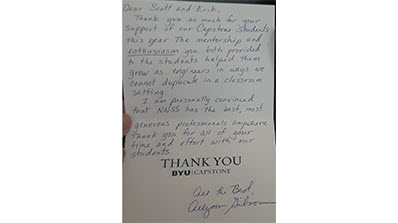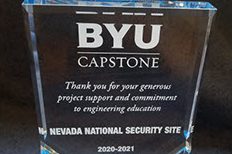The 2020/2021 Brigham Young University (BYU) Capstone Team was tasked with advancing Nevada National Security Site (NNSS)-derived concepts of COVID-19 detection by utilizing Commercial Off-The-Shelf (COTS) hardware and open source machine learning tools for novel human performance analytics-assessment capability. Working with Erik Stassinos, NNSS Applied Technologies Technical Projects manager, and Scott Sonnon, NNSS Human Performance Analytics Program manager, the team focused efforts on two activities: first, developing and refining machine learning analysis of respiratory and cardiology data sets to visualize abnormal mechanical breathing performance, and synchronization of heart rate and respiration rate; and second, creating a visualization tool for a user to analyze their collected data in an efficient and actionable manner. The NNSS Site-Directed Research and Development (SDRD) technical development team approached the students as technical peers, allowing them to exercise real-world engineering concepts.
BYU Capstone Team #34, sponsored by NNSS, communicated with NNSS technical advisors through weekly email reports on progress, and successfully developed both an analytics tool for synchronicity and a user front-end for visualizing data parameters. Technical details on synchronizing were provided to the team based on scientific biomedical research publications. The concept that respiration and electrocardiogram (ECG) signals are two oscillators allows the mathematical phase linking between them. Pulling respiration and ECG data from the COTS wearable sensor cloud, the team implemented PyTorch and TensorFlow machine learning tools, filtering and treating imported data sets as data “clusters” and utilizing a 20 percent deviation margin to flag data of potential interest. The team implemented MATLAB tools to validate this approach, and displayed the generated synchronized data along with other data signals in their developed graphical user interface.

Stassinos notes that the BYU Capstone project benefits both NNSS and the students. “The collaboration with BYU students highlighted the impressive abilities students had in developing engineering methodology, and their understanding of the patience and persistence required for engineering research that does not always follow a linear path,” he observed. “SDRD leverages technology based on current state of the art for wearable sensors, and the design and release cadence of some of these technologies is on the order of months. Having access to young talent not only provides students the opportunity to engage in technical activities within NNSS, but also provides NNSS research programs the opportunity to access new creative thinking. New technology exposure that young individuals in STEM programs often have access to provides opportunity for novel solution paths for the hard problems that NNSS pursues in its site-directed research.”
Several NNSS partners have expressed interest in harnessing the capabilities developed through the Capstone project for their own groups and teams, and the technology has been presented to other businesses and agencies within the national healthcare system as another tool to use in our national response to the COVID-19 pandemic. Understanding what sort of impacts there are to cardiorespiratory performance from COVID symptoms and pre-symptoms continues to be an important element of the search for more effective and accurate diagnoses and treatments, and the technology developed by BYU Capstone Team #34 and NNSS can help collect and visualize useful data for that research in a unique and easily-visualized way.
For more information about BYU’s Capstone program, visit https://capstone.byu.edu/.

